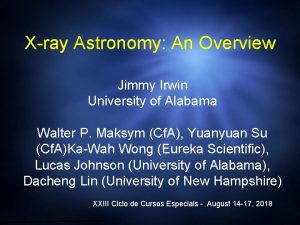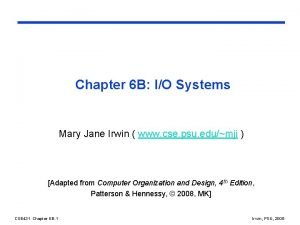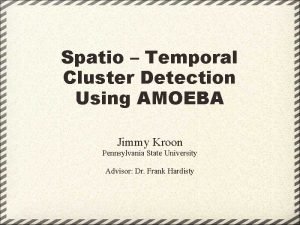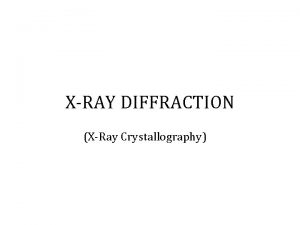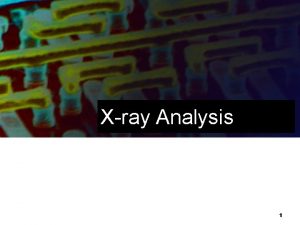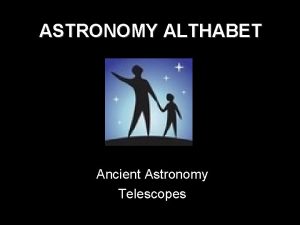Xray Astronomy An Overview Jimmy Irwin University of
















































- Slides: 48

X-ray Astronomy: An Overview Jimmy Irwin University of Alabama Walter P. Maksym (Cf. A), Yuanyuan Su (Cf. A)Ka-Wah Wong (Eureka Scientific), Lucas Johnson (University of Alabama), Dacheng Lin (University of New Hampshire) XXIII Ciclo de Cursos Especiais - August 14 -17, 2018

Alabama

Course Schedule Day 1 – Introduction to X-ray astronomy Day 2 – X-rays from lone stars X-ray binaries/Ultraluminous X-ray sources Day 3 – AGN/Gas inside the Bondi radius/tidal disruptions Hot gas in galaxies Day 4 – Gas in groups and clusters of galaxies X-ray Spectral Fitting

X-ray Astronomy Basics http: //www. radioqrv. com/Radio. QRV%20 -%20 Electromagneti %20 Spectrum. html Units of measurement: ke. V (kilo-electron volt) 1 ke. V = 1. 6 x 10 -16 Joules = 1. 6 x 10 -9 ergs Temperatures given in units of k. T, where 1 ke. V corresponds to a temperature of 1. 16 x 107 Kelvin

X-ray Astronomy Basics http: //www. radioqrv. com/Radio. QRV%20 -%20 Electromagneti %20 Spectrum. html Typical “soft” X-ray energy/wavelength band is 0. 1 – 10 ke. V or 124 – 1. 24 Angstroms “Hard” X-ray is energy band 10 – 100 ke. V or 1. 24 – 0. 12 Angstroms

Why Can’t We All Get Along? ? Optical Radio X-ray Wavelength/Energy: Angstrom cm/mm/Hz ke. V or Angstrom Temperature: Energy Flux/ Density: Luminosity: Telescope Exposure: Kelvin magnitude Kelvin ke. V Janskys ergs s-1 cm-2 abs. mag. or L Watts ergs s-1 hours kilosec

Typical X-ray Parameter Values Temperature: hot gas in supernovae remnants or elliptical galaxies – 0. 3 – 1 ke. V hot gas in groups/clusters of galaxies – 2 – 10 ke. V X-ray binary accretion disks – 1 – 2 ke. V stellar coronae – 0. 1 ke. V X-ray Luminosity (typically in 0. 1 – 10 ke. V energy band): Sun – 1027 ergs s-1 Eddington-limited neutron star – 1038 ergs s-1 Typical X-ray AGN - 1041 ergs s-1 Gas-rich elliptical galaxy – 1040 -41 ergs s-1 Rich cluster of galaxies – 1044 -45 ergs s-1 Brightest X-ray quasars – 1047 ergs s-1

X-ray Emission Mechanisms – Blackbody Radiation Optically thick gas at temperatures exceeding a few million Kelvin will emit in the X-ray regime L R 2 T 4 Accretion disks around stellar-mass black holes are hot enough/dense enough to emit as blackbodies with characteristic temperatures of ~1 ke. V. In fact, a single accretion disk can contain gas with a cascade of different blackbody temperatures blended together.

electron X-ray Emission Mechanisms – Bremsstrahlung Optically thin gas is so hot that electrons are all or mostly all ioinzed proton Hot X-ray gas cools and emits Xrays through a process called thermal bremsstrahlung, or “braking radiation” in an optically thin gas Also called “free-free emission” because the electron remains free before and after the interaction Energy emitted is proportional to T 1/2 * ne * ni, where T= temperature, ne = electron density, ni = ion density

Radiation Processes – Inverse Compton Scattering Hot electrons can upscatter lower energy photons to higher energies via inverse Compton scattering. For example, optical/UV photons from the disks of AGN can be upscattered to X-ray energies by energetic electrons in a corona around the black hole.

Radiation Processes – Synchrotron + Self Comptonization Relativistic electrons spiraling down strong magnetic field lines will emit radiation as they do so, generically a power law spectrum. This can lead directly to X-ray emission (pulsars), or radio photons that are then inverse Compton scattered up to X-ray energies (AGN).

Radiation Processes – Metal Line Emission http: //ixo. gsfc. nasa. gov/images/science/goals 17 Starburst. png OVII – oxygen missing 6 electrons Ne X - neon missing 9 electrons Mg XI – magnesium missing 10 electrons Note how highly ionized the metals are – nearly all electrons have been removed, because of the very high temperature of the gas (0. 3 ke. V – 15 ke. V, depending on the object). In the hottest clusters, even iron (Fe) is almost completely ionized.

Radiation Processes – Metal Line Emission http: //ixo. gsfc. nasa. gov/images/science/goals 17 Starburst. png OVII – oxygen missing 6 electrons Ne X - neon missing 9 electrons Mg XI – magnesium missing 10 electrons In additional to thermal bremsstrahlung emission, there also electron transition emission lines from metals within the gas: Metal lines from relevant elements (Fe, Ni, O, Mg, Ne, S, Si)

X-ray Absorption X-rays are susceptible to absorption by the Milky Way, the ISM of external galaxies, and/or absorption intrinsic to the object itself (i. e. , absorbing gas in the torus surrounding an AGN). Amount of absorption depends on whether the gas is optically thick or optically thin at a particular energy, as well as the elemental abundance of the absorbing gas. The optical depth, (E), describes the opacity of the gas as a function of energy, and is more significant at softer energies.

Opacity and is a measure of how many interactions on average a photon will encounter while traveling through a medium Opacity = A measure of the number of absorbers a photon will run into over some length Opacity is often measured in terms of = density of absorbers x cross section of each sphere x path length (L) Units: 1/volume x area x length = dimensionless number Imagine that dots represent the absorption cross-section of molecules in a gas

Opacity and For very small , is approximately the percentage of photons that get absorbed passing through the material. i. e. , if = 0. 01, ~1% of the incident photons are absorbed by the material, with ~99% getting through. What if is larger?

Opacity and Each narrow slab of material absorbs a small percentage of the incident photons. Over many layers, photon flux diminishes more and more. Differential (negative) change in flux, d. I in going through any thin slab of optical depth d is proportional to the incident flux I: d. I = - I d --> d. I/I = -d

Opacity and d. I/I = -d Solve differential equation: ∫ d. I/I = ∫ -d ln I - ln I 0 = - ln (I/I 0) = - I = I 0 e- Incident flux I 0 on left side of slab diminishes exponentially with increasing

Galactic Hydrogen Column Density NH Galactic NH ranges from 7 x 1019 to 2 x 1022 cm-2 across the sky. Dickey & Lockman 1990 (E) = σ(E) NH, where σ(0. 07, 0. 25, 1, 10 ke. V) = (600, 40, 2, 0. 1) x 10 -22 cm 2 In highly obscured AGN, with (intrinsic) absorption exceeding 1023 cm-2, virtually all photons below 3 ke. V are absorbed ROSAT missed highly obscured AGN!

Effect of NH on X-ray Spectra Effects of absorption on a pure power law spectrum. Courtesy Neil Brandt notes

X-ray Telescopes Cosmic Perspective, Bennett et al. Earth’s atmosphere is opaque to X-rays need to get above atmosphere 1960 s/70 s – balloon/sounding rocket experiments demonstrated that the sky was X-ray active

X-ray Telescopes Cosmic Perspective, Bennett et al. 1970 s/80 s – non-imaging (UHURU), and early imaging (Einstein, EXOSAT, Ginga) X-ray satellites – limited spatial/spectral resolution 1990 s – X-ray telescope technology begins to expand with first soft Xray all-sky survey (ROSAT), first X-ray detector utilizing CCDs (ASCA), as well as joint hard/soft X-ray detectors (Beppo. Sax) and Xray timing experiments (RXTE)

Current X-ray Telescopes NASA’s Chandra X-ray Observatory Launch: July 23, 1999 Energy: 0. 2 – 10 ke. V ACIS - Advanced CCD Imaging Spectrometer (10 CCDs) + high resolution gratings (LETG, HETG) HRC - High Resolution Camera (timing) BY FAR the best spatial resolution Spatial resolution: 0. 5” of any X-ray telescope

Instruments of Chandra ACIS-I/S have timing resolution of 3. 2 seconds, and spectral resolution of E/ΔE = 10– 20 HRC has timing resolution of 16 microseconds HETG/LETG have coverage of 0. 1 – 10 ke. V and an energy resolution of E/ΔE = 100– 1000

X-ray (pre-Chandra) vs. Optical ROSAT PSPC Digital Sky Survey NGC 4697

ROSAT vs. 30’’ resolution Chandra 0. 5’’ resolution NGC 4697

Current X-ray Telescopes ESA’s XMM-Newton X-ray Observatory Launch: December 10, 1999 Energy: 0. 2 – 12 ke. V EPIC – European Photon Imaging Cameras (3 separate instruments with CCDs) RGS – Reflection Grating Spectrometers (E/ΔE = 300) Spatial resolution: 6” Largest collecting area of any telescope in 0. 2 -10 ke. V range – currently 9 x that of Chandra

Instruments of XMM-Newton EPIC: 2 MOS detectors s and a PN detector: CCDs with E/ΔE = 200– 800 at 6. 5 ke. V 2 Reflection Gratings Spectrometers (RGS): 0. 4 – 2. 5 ke. V coverage, E/ΔE = 200– 800 Optical Monitor (OM) – 30 -cm telescope with 6 filters covering 1800– 6000 Angstroms. Limiting magnitude B ~ 24.

Current X-ray Telescopes NASA’s Neil Gehrels Swift Observatory Launch: November 20, 2004 XRT – CCD sensitive in 0. 2 – 10 ke. V band) UVOT – simultaneous ultraviolet/optical coverage Spatial resolution: 18” Capable of fast slew to position of GRBs. Also suitable for short monitoring observations.

Current X-ray Telescopes NASA/Caltech’s Nu. STAR Telescope Launch: June 13, 2012 Sensitive in 3 – 79 ke. V energy range Harrison et al. 2013 Spatial resolution: 58” First telescope capable of imaging at hard (>10 ke. V) X-ray imaging.

X-ray Telescopes Comparison Harrison et al. 2013 2007 X-ray Astronomy School - K. Arnaud

Future X-ray Telescopes JAXA/NASA’s X-ray Recovery Mission (XARM) Expected Launch: 2021 RESOLVE – soft X-ray calorimeter spectrometer (0. 3 – 12 ke. V) – energy resolution of 5 – 7 e. V (R = 1000 at 6 ke. V) XTEND – soft X-ray imager in the 0. 4 – 13 ke. V energy range Hopefully the first X-ray microcalorimeter to survive more than a few days!

Future X-ray Telescopes NASA’s Midex Mission Arcus Expected Launch: 2023 (if approved) Large collecting area gratings (0. 25 – 1 ke. V) – energy resolution of R ~ 3000

Future X-ray Telescopes ESA’s Athena Observatory Expected Launch: early 2030 s 5” spatial resolution 3 e. V spectral resolution 13 x collecting area of XMM-Newton Effectively, super-XMM with a spectral calorimeter.

Future X-ray Telescopes NASA’s Lynx Observatory Expected Launch: 203? 0. 5” spatial resolution 3 e. V spectral resolution 50 x collecting area of Chandra Everything you could ever want in an X-ray telescope, but will it ever come to fruition?

X-ray Telescope Optics X-rays must be “skipped” in at shallow angles (“grazing incidence”) – very long focal lengths Single photon counters – position, energy, time of each photon is recorded (much unlike optical telescopes) get spatial, spectral, timing information simultaneously.

X-ray Detection – Spatial Centaurus A Perseus Galaxy Cluster Chandra Science Center images M 31

X-ray Detection – Spatial Supernova remnant Cas A blue – Ti-44 map X-ray surface brightness profile of galaxy cluster Abell 3667 Elliptical galaxy NGC 4649 in 0. 3 – 2. 0 ke. V (upper) and 2. 0 – 7. 0 ke. V (lower) energy band.

X-ray Detection – Spatial X-ray images can be affected by: – CCD chip gaps – vignetting – worsening off-axis PSF

X-ray Detection – Spectral X-ray spectra can be obtained for any source (or region of a spatially extended source) for which a sufficient number of counts can be obtained. Elliptical galaxy NGC 4374 AE Aquarii - Oruru & Meintjes (2012)

X-ray Detection – Spectro-Spatial Temperature map of galaxy cluster Abell 1914 Fe abundance map of M 87 – Owen et al. (2000)

X-ray Detection – Timing Since each photon arrival time is recorded, timing analysis can be done traditionally (# of photons in fixed time bins), a power density spectrum, or on a photon-by-photon basis: http: //science. psu. edu/alert/images/Circinus_graph 300. jpg Gao et al. 2017 Irwin et al. 2016

X-ray Detection – Timing Spectra can be obtained as a function of X-ray intensity level by separating an observation into time intervals based on the X-ray count rate during that interval. Enoto et al. 2014

How Can I Acquire X-ray Data? Method #1: Write a telescope observing proposal! Call for proposals happens usually once a year: – GO, or Guest Observer proposals – To. O – Target of Opportunity – TC – Time-constrained observations (or coordinated with other observatories) Most observatories have Director’s Discretionary Time (DDT) that can be requested throughout the year, for compelling or particularly time crucial observations.

How Can I Acquire X-ray Data? Method #1: Write a telescope observing proposal! What makes a good X-ray observing proposal? 1) A compelling, and to-the-point science case – don’t get bogged down in details, think ‘big picture’ 2) Technical feasibility is crucial – panel will not accept proposals that they think cannot be accomplished with the requested exposure time 3) Have good secondary science – can you accomplish more than one goal with the observation?

How Can I Acquire X-ray Data? Method #1: Write a telescope observing proposal! What makes a good X-ray observing proposal? 4) Remember, reviewers are looking at a lot of proposals at once (up to 70 for Chandra proposals). Do not assume they will have time to appreciate very subtle points that are crucial to your argument. Be blunt.

How Can I Acquire X-ray Data? Method #1: Write a telescope observing proposal! Usual Deadlines: Chandra: mid-March XMM-Newton: early October Swift: late September Nu. STAR: late January Most X-ray observatories have joint request avenues with the other X-ray observatories.

How Can I Acquire X-ray Data? Method #2: Download data from the data archive Unlike some ground-based observatories, X-ray data becomes publically available after a (usually) 12 -month proprietary period. Photon-by-photon listing of photon position, energy, and arrival time stored in an event file. Other secondary files may be needed to analyze the data properly.
 Jimmy irwin
Jimmy irwin Learning astronomy by doing astronomy
Learning astronomy by doing astronomy Learning astronomy by doing astronomy activity 1 answers
Learning astronomy by doing astronomy activity 1 answers Learning astronomy by doing astronomy
Learning astronomy by doing astronomy Msu physics and astronomy
Msu physics and astronomy Letter to lord irwin
Letter to lord irwin Gandhi rhetorical analysis
Gandhi rhetorical analysis Altman and taylor
Altman and taylor Acherola
Acherola The hard way out by terry vaughn genre and subgenre
The hard way out by terry vaughn genre and subgenre Dylan irwin
Dylan irwin Howard irwin titanic
Howard irwin titanic Dalmas taylor
Dalmas taylor Irwin sanders
Irwin sanders Irwin rosenstock
Irwin rosenstock Bad boy walter dean myers
Bad boy walter dean myers Mr irwin lasher
Mr irwin lasher Altman and taylor
Altman and taylor De jong
De jong Irwin rose indianapolis
Irwin rose indianapolis Irwin seating dealers
Irwin seating dealers Coming home mary irwin
Coming home mary irwin Vertebrae
Vertebrae Mary jane irwin
Mary jane irwin Primerica rvp salary
Primerica rvp salary Jimmy ichihana
Jimmy ichihana Jimmy huang nottingham
Jimmy huang nottingham Jimmy frey wikipedia
Jimmy frey wikipedia Jimmy carter
Jimmy carter Gadsden purchase jimmy fallon
Gadsden purchase jimmy fallon Leeftijd jimmy frey
Leeftijd jimmy frey Barry liked playing board games
Barry liked playing board games Coupon craze
Coupon craze Jimmy cournoyer
Jimmy cournoyer Jimmy akintonde
Jimmy akintonde Lead singer of jimmy eat world
Lead singer of jimmy eat world Jimmy kennedy istanbul
Jimmy kennedy istanbul Jimmy goh giam hwee
Jimmy goh giam hwee Sam's club jimmy dean sausage biscuits
Sam's club jimmy dean sausage biscuits Jimmy burleson
Jimmy burleson Penulties
Penulties Jimmy chen eqt
Jimmy chen eqt Jimmy kroon
Jimmy kroon Cygtnlit
Cygtnlit Jimmy neutron macbeth
Jimmy neutron macbeth Jimmy doors
Jimmy doors Jimmy hermansson
Jimmy hermansson Jimmy ryce
Jimmy ryce Santiago
Santiago
